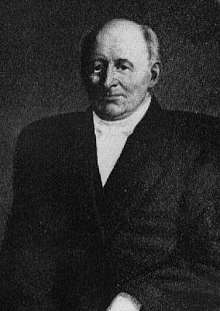Heinrich Schwabe
Samuel Heinrich Schwabe (25 October 1789 – 11 April 1875) a German astronomer remembered for his work on sunspots.
Samuel Heinrich Schwabe | |
|---|---|
 | |
| Born | 25 October 1789 |
| Died | 11 April 1875 (aged 85) |
| Nationality | German |
| Known for | sunspots |
| Awards | Gold Medal of the Royal Astronomical Society (1857) |
| Scientific career | |
| Fields | astronomy |
Schwabe was born at Dessau. At first an apothecary, he turned his attention to astronomy, and in 1826 commenced his observations on sunspots. Schwabe was looking for a possible planet inside inside the orbit of Mercury. Because of the proximity to the Sun, it would have been very difficult to observe such a planet, and Schwabe believed one possibility to detect a new planet might be to see it as a dark spot when passing in front of the Sun. For 17 years, from 1826 to 1843, on every clear day, Schwabe would scan the Sun and record its spots trying to detect any new planet among them. He did not find any planet but noticed the regular variation in the number of sunspots and published his findings in a short article entitled "Solar Observations during 1843".[1] In it he made the suggestion of a probable ten-year period (i.e. that at every tenth year the number of spots reached a maximum). This paper at first attracted little attention, but Rudolf Wolf who was at that time the director of Bern observatory, was impressed so he began regular observations of sunspots. Schwabe's observations were afterwards utilized in 1850 by Alexander von Humboldt in the third volume of his Kosmos.[2] The periodicity of sunspots is now fully recognized; and to Schwabe is thus due the credit of one of the most important discoveries in astronomy.
In 1857 Schwabe was awarded the Gold Medal of the Royal Astronomical Society.
References
- Schwabe (1843). "Sonnenbeobachtungen im Jahre 1843" [Observations of the sun in the year 1843]. Astronomische Nachrichten [Astronomical News] (in German). 21: 233–236. From page 235: "Vergleicht man nun die Zahl der Gruppen und der flecken-freien Tage mit einander, so findet man, dass die Sonnenflecken eine Periode von ungefähr 10 Jahren hatten … " (If one compares the number of groups [of sunspots] and the sunspot-free days with one another, then one finds that the sunspots had a period of about 10 years … )
- Humboldt, Alexander von (1850). Kosmos: Entwurf einer physischen Weltbeschreibung [Cosmos: Outline of a physical description of the world] (in German). vol. 3. Stuttgart and Tübingen, (Germany): J. G. Cotta'scher Verlag. pp. 401–402. From pp. 401–402: "Die in der nachfolgenden Tabelle enthaltenen Zahlen lassen wohl keinen Zweifel übrig, daß wenigstens vom Jahre 1826 bis 1850 eine Periode der Sonnenflecken von ohngefähr 10 Jahren in der Art statt gefunden hat: … " (The numbers contained in the following table leave no doubt that at least from the year 1826 to 1850, a period for sunspots of about 10 years or so has occurred: … )
- English translation: Humboldt, Alexander von; Otte, E.C., trans.; Paul, B.H., trans. (1868). Cosmos: A Sketch of a Physical Description of the Universe. vol. 4. New York, New York, USA: Harper & Brothers. p. 85. From p. 85: "The numbers contained in the following table leave no doubt that, at least from the year 1826 to 1850, the occurrence of [sun] spots has been so far characterized by periods of ten years, … "

External links
- Excerpts from Solar Observations During 1843 by Heinrich Schwabe .
- Address delivered by the President of the RAS on presenting the Gold Medal of the Society to M. Schwabe
- HAO "S. Heinrich Schwabe (1789-1875)"
- HAO "S. Heinrich Schwabe (1789-1875)" with portrait.
- Chris Plicht "Schwabe, Samuel Heinrich (1789 - 1875)"
- The Sun—History